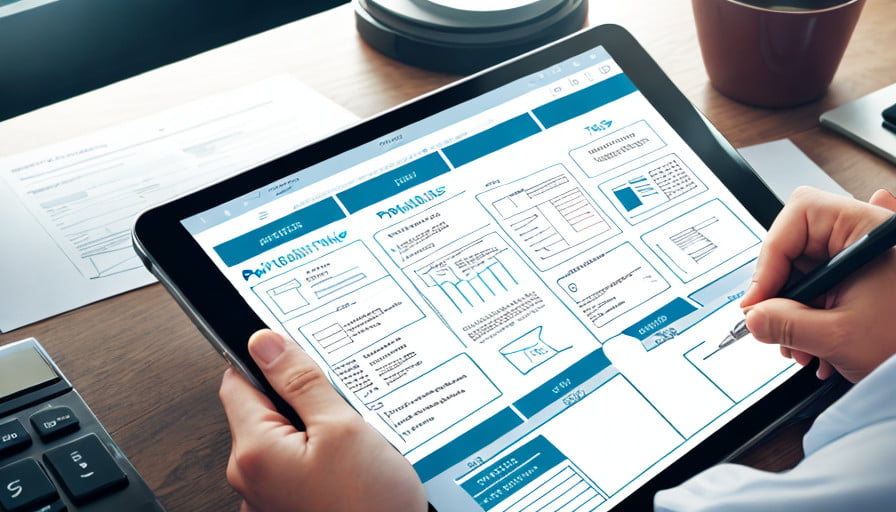Business planning is the process of defining your business’s objectives, strategies, and plans to achieve those objectives. It’s an essential part of any business’s success, serving as a roadmap that guides strategic decision-making and helps align all aspects of the business towards a common goal.
The role of business planning in strategic decision-making is paramount. It helps businesses identify their mission and vision, understand their market, and develop effective strategies to achieve their goals. It also provides a framework for tracking progress, evaluating performance, and making necessary adjustments to stay on course.
Understanding the Business Planning Process
The business planning process generally involves several key steps:
- Research: This involves gathering and analyzing data about the business’s industry, target market, competitors, and costs. It’s crucial for understanding the business environment and identifying opportunities and challenges.
- Strategize: Based on the research, the business develops a strategy to achieve its objectives. This could involve identifying key performance indicators, setting goals, and outlining the steps needed to reach those goals.
- Draft the Plan: The business plan is then drafted using the research and strategy. It should clearly outline the business’s mission, vision, goals, strategies, and how it plans to achieve its objectives.
- Present the Business Plan: The business plan is presented to stakeholders, including employees, investors, and partners. It should highlight key points and provide a clear overview of the business’s strategy and plans for the future.
Detailed Breakdown of Each Step
Research
Research is the first and most critical step in the business planning process. It involves gathering and analyzing data about the business’s industry, target market, competitors, and costs.
- Industry Analysis: This involves studying the business’s industry to understand its trends, opportunities, and challenges. It helps the business identify its position in the industry and develop strategies to stay competitive.

- Market Analysis: This involves understanding the business’s target market, including demographics, preferences, and buying behavior. It helps the business tailor its products or services to meet the needs and preferences of its customers.
- Competitor Analysis: This involves studying the business’s competitors to understand their strengths, weaknesses, and strategies. It helps the business identify opportunities for differentiation and develop effective strategies to compete effectively.
- Cost Analysis: This involves estimating the costs associated with running the business, including operational costs, overhead costs, and investment costs. It helps the business set realistic financial goals and develop cost-effective strategies.
Strategize
Strategizing is the process of developing a plan to achieve the business’s objectives. It involves setting clear goals, outlining the steps needed to reach those goals, and identifying the resources and actions required to implement the plan.
- Set Goals: The first step in strategizing is setting clear and achievable goals. These goals should be specific, measurable, attainable, relevant, and time-bound (SMART). They should align with the business’s mission and vision and provide a clear direction for the business.
- Develop Strategies: Once the goals are set, the business needs to develop strategies to achieve those goals. This could involve identifying key performance indicators, outlining the steps needed to reach the goals, and setting a timeline for implementation.
- Resource Allocation: The business also needs to identify the resources required to achieve its goals and allocate those resources effectively. This could involve identifying skilled personnel, securing funding, and allocating time and other resources.
Draft the Plan
Drafting the business plan involves putting all the information gathered and strategies developed into a comprehensive document. The business plan should clearly outline the business’s mission, vision, goals, strategies, and how it plans to achieve its objectives.
- Mission and Vision: The business plan should start with the business’s mission and vision. These statements provide a clear overview of the business’s purpose and direction.
- Goals and Objectives: The business plan should then outline the business’s goals and objectives. These should be specific, measurable, and aligned with the business’s mission and vision.
- Strategies: The business plan should detail the strategies the business will use to achieve its goals and objectives. This could involve outlining key performance indicators, identifying key actions, and setting a timeline for implementation.
- Implementation Plan: The business plan should also include an implementation plan. This outlines how the business will put its strategies into action, including identifying the resources needed, setting a timeline, and assigning responsibilities.
Present the Business Plan
The final step in the business planning process is presenting the business plan to stakeholders. This could include employees, investors, partners, and other key stakeholders.
- Stakeholder Engagement: The business plan should be presented to all relevant stakeholders. This helps ensure that everyone understands the business’s strategy and plans for the future.
- Feedback and Adjustments: After presenting the business plan, the business should seek feedback from stakeholders. This feedback can be used to make necessary adjustments to the business plan.
- Plan Refinement: The business plan should be refined based on the feedback received. This ensures that the business plan is aligned with the needs and expectations of all stakeholders.
Importance of Business Planning
Business planning is not just about creating a document. It’s about creating a roadmap for success. A well-executed business plan can help businesses attract investors, achieve their goals, and adapt to changes in the business environment.

- Attracting Investors: A well-executed business plan can help businesses attract investors. Investors want to see that the business has a clear vision, understands its market, and has a strategy to achieve its goals.
- Achieving Goals: A business plan provides a clear direction for the business. It outlines the business’s goals and how it plans to achieve them. This helps the business stay focused and motivated to achieve its goals.
- Adapting to Changes: The business environment is constantly changing. A business plan provides a framework for adapting to these changes. It helps the business identify opportunities and challenges, and develop strategies to respond effectively.
Common Mistakes to Avoid When Drafting a Business Plan
When drafting a business plan, it’s essential to avoid common mistakes that could undermine its effectiveness. Here are some key mistakes to avoid:
- Skipping Idea Validation: Overestimating the importance of the idea is a common mistake. While a new idea can be exciting, it’s crucial to validate the idea before investing significant time and resources into it. This can be done by conducting market research, speaking with potential customers, and getting feedback from industry experts.
- Creating a Theoretical Business Plan: Another common mistake is creating a business plan based on assumptions rather than real-world data. Instead, it’s important to create an experimentation-based plan that’s grounded in real-world data and customer feedback.
- Poor Grammar and Wording: Errors in grammar and wording can make your business plan difficult to understand. It’s essential to proofread your business plan and consider getting it reviewed by an editor or a professional writer.
- Off-Putting Style: The style of your business plan should be authoritative and realistic. Avoid conversational or folksy language that could make your business plan seem less professional or credible.
- Sloppy Format: Your business plan should be well-structured and easy to understand. This includes using consistent font styles, spacing, and margins. Include supplemental materials like charts or graphs in a way that enhances the narrative rather than interrupting it.
- Inadequate Research: Your business plan should be based on thorough research. This includes understanding your industry, target market, competitors, and market trends. Use data and statistics to back up your assumptions and projections.
- Claiming No Risk: Every business carries some level of risk. It’s important to identify these risks and discuss strategies for mitigating them in your business plan.
- Claiming No Competition: Every successful business has competitors, both direct and indirect. It’s important to identify these competitors and discuss how your business will compete effectively in your business plan.
How Often Should a Business Plan be Updated or Revised?
A business plan should be updated or revised regularly, typically every 6 to 12 months. This is to ensure that the plan remains relevant and aligned with the business’s current goals, market conditions, and strategies. However, the frequency of updates may vary depending on the nature of the business and the pace of change in its industry.
Effective Ways to Present a Business Plan to Stakeholders
Presenting a business plan to stakeholders effectively involves several key steps:

- Clear and Concise Communication: Use clear and concise language to explain your business plan. Avoid jargon and complex terms that could confuse your audience.
- Visual Aids: Use visual aids like charts, graphs, and diagrams to illustrate key points in your business plan. This can make your presentation more engaging and easier to understand.
- Stakeholder Engagement: Engage with your stakeholders by seeking their feedback and addressing their questions. This can help ensure that your business plan is aligned with their needs and expectations.
- Feedback and Adjustments: After presenting your business plan, seek feedback from your stakeholders. Use this feedback to make necessary adjustments to your business plan.
How to Use a Business Plan to Identify and Address Risks
A business plan can be a powerful tool for identifying and addressing risks. Here’s how you can use it:
- Risk Assessment: Include a risk assessment in your business plan. This should identify potential risks that could impact your business and discuss strategies for mitigating these risks.
- Contingency Planning: Develop contingency plans for dealing with unexpected events or challenges. This could include plans for dealing with competitors, changes in the market, or other unforeseen circumstances.
- Monitoring and Adjusting: Regularly monitor your business for signs of risk and adjust your plans as necessary. This could involve tracking key performance indicators, conducting market research, or seeking feedback from stakeholders.
By identifying and addressing risks, you can help ensure the success of your business and protect it from potential challenges.
Conclusion
In conclusion, the business planning process is a critical component of any business’s success. It provides a framework for defining objectives, developing strategies, and making strategic decisions. By understanding and implementing the business planning process, businesses can increase their chances of success and achieve their goals.You should consider reading another article i wrote about >>>> How to Start an Event Planning Business to learn more.
As an author writing and creating business courses and articles, I am responsible for developing and delivering high-quality content that is informative, engaging, and relevant to the target audience.
I monitor and analyzes business trends and topics to create courses and articles that provide value to readers and students here. I am responsible for ensuring that all content is accurate, well-written, and met the needs of the target audience.








